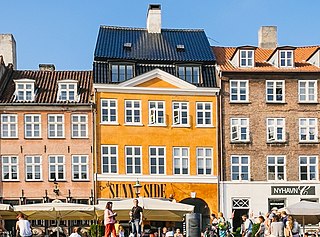
Nyhavn 31 is a listed property overlooking the Nyhavn canal in central Copenhagen, Denmark.

Nyhavn 33 is a listed property overlooking the Nyhavn canal in central Copenhagen, Denmark.
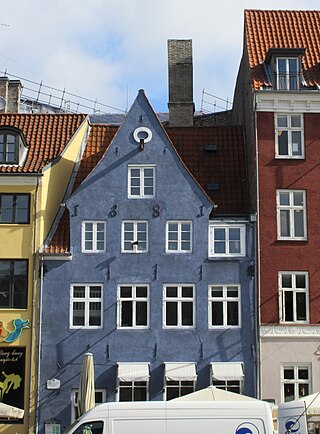
Nyhavn 9 is a historic townhouse overlooking the Nyhavn Canal in central Copenhagen, Denmark. It dates back to the 17th century and is one of few buildings along the canal that was not heightened in the 19th century. The building was listed on the Danish Registry of Protected Buildings and Places in 1918. It houses a restaurant in the ground floor.

Nyhavn 15 is a historic townhouse overlooking the Nyhavn Canal in central Copenhagen, Denmark. The building was listed in the Danish registry of protected buildings and places in 1945.

Nyhavn 63 is a historic townhouse overlooking the Nyhavn Canal in central Copenhagen, Denmark. The building is listed on the Danish Registry of Protected Buildings and Places. A warehouse in the courtyard has been converted into a hostel.

Nyhavn 41 is a listed property overlooking the Nyhavn canal in central Copenhagen, Denmark. It was listed in the Danish registry of protected buildings and places in 1918.

Amaliegade 4 is a historic property located in the Frederiksstaden Quarter of central Copenhagen, Denmark. It was built for sugar manufacturer Christian Rønnenkamp in 1829 and was listed on the Danish Registry of Protected Buildings and Places in 1950. Other notable former residents include politician Christian Albrecht Bluhme and painter Viggo Johansen.
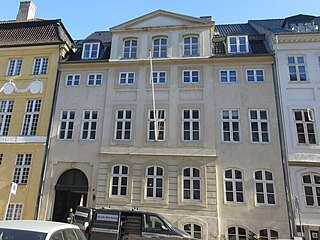
Amaliegade 16 is a historic building located next to the Yellow Mansion in the heart of the Frederiksstaden district of central Copenhagen, Denmark. The building dates from the 1750s but was altered in the second half of the 18th century. It was listed on the Danish registry of protected buildings and places in 1918.

Nyhavn 27 is an 18th-century property overlooking the Nyhavn Canal in central Copenhagen, Denmark. The building was listed in the Danish registry of protected buildings and places in 1945. Notable former residents include businessman Andreas Bodenhoff.

Nyhavn 55 is a just three-bays-wide, 18th-century canal house overlooking the Nyhavn Canal in central Copenhagen, Denmark. The building was listed in the Danish registry of protected buildings and places in 1918. The heritage listing comprises a half-timbered perpendicular side wing on its hear.

Lille Strandstræde 10 is an 18th-century property situated in the Nyhavn Quarter of central Copenhagen, Denmark. It was listed in the Danish registry of protected buildings and places in 1988.

Lille Strandstræde 18 os a Neoclassical property situated off Sankt Annæ Plads in central Copenhagen, Denmark. It was listed in the Danish registry of protected buildingsand places om 1950-

Nyhavn 45 is an 18th-century property overlooking the Nyhavn Canal in central Copenhagen, Denmark. It was listed in the Danish registry of protected buildings and places in 1945.
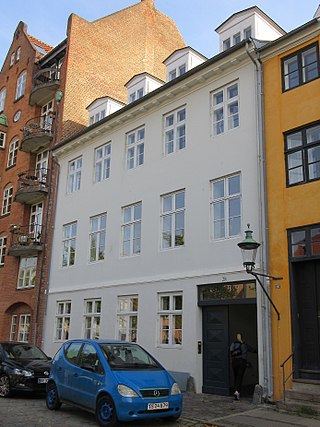
Overgaden Oven Vandet 28 is an 18th-century property overlooking Christianshavn Canal in the Christianshavn neighborhood of central Copenhagen, Denmark. It was listed in the Danish registry of protected buildings and places in 1945. Notable former residents include publisher Frederik Hegel and painter Heinrich Hansen.

Nyhavn 20 is a 17th-century building overlooking the Nyhavn canal in central Copenhagen, Denmark. It was listed in the Danish registry of protected buildings and places in 1945. The building houses a bar in the basement and a residential apartment on the upper floors. The facade features a relief of a fish above the main entrance, flanked by two reliefs of sailing ships.

Nyhavn 61 is an 18th-century residential building overlooking the Nyhavn canal in central Copenhagen, Denmark. The building was listed in the Danish registry of protected buildings and places in 1945. The scope of the heritage listing was expanded in 1984. Nyhavn 61 and Nyhavn 59 have now been merged into a single property and are physically integrated on the third floor. The two buildings share a central courtyard.

Nyhavn 21/Lille Strandstræde 4, formerly known as Hotel L'ven, Hotel Kronprinsen and Fredsfondens Hus, is a complex of historic buildings overlooking the Nyhavn canal in central Copenhagen, Denmark. It consists of a late 17th-century building in Nyhavn and a just two bays wide building in Lille Strandstræde as well as a two-storey rear wing from 1748. It was listed in the Danish registry of protected buildings and places in 1945. The restaurant Cap Horn was a popular jazz venue in the 1950s. It is now part of the Tholstrup restaurant group. Notable former residents include the politician Jens Christian Christensen and painters Anna and Michael Ancher.
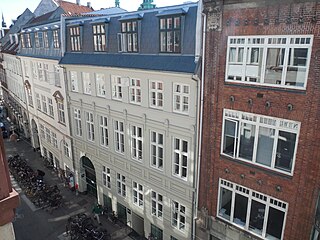
Vestergade 7 is a Neoclassical building complex situated close to Gammeltorv in the Old Town of Copenhagen, Denmark. It was constructed for royal building inspector Andreas Kirkerup as part of the building of the city following the Copenhagen Fire of 1795. The property was listed on the Danish registry of protected buildings and places in 1991. Notable former residents include the master builder Johan Boye Junge and archeologist Peter Oluf Brøndsted. The Danish Institute for Study Abroad (DIA) is now based in the building. The adjacent building at Vestergade 5 is also owned by the Danish Institute for Study Abroad.
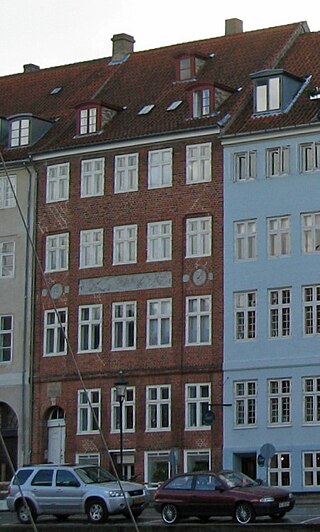
Nyhavn 8 is an 18th-century property overlooking the Nyhavn canal i central Copenhagen, Denmark. It was listed in the Danish registry of protected buildings and places in 1918. A sandstone tablet with inscription above the arched main entrance commemorates a time when Dragør skippers used to stay in the building during the winter months.

Nyhavn 6 is a Neoclassical building situated on the quiet southern side of the Nyhavn canal in central Copenhagen, Denmark. It was listed in the Danish registry of protected buildings and places in 1950. Composer Carl Nielsen and sculptor Anne Marie Carl-Nielsen had their first home together in the garret in the 1890s.






















